In Part 1 and Part 2, we met STAN WOO, who back in 1985 convinced GEORGE TAKEI to star as Sulu and JAMES SHIGETA to appear as Admiral Nogura in Stan’s Star Trek fan film YORKTOWN: A TIME TO HEAL. If you haven’t seen it yet, here is the completed film (released on April 5, 2022)…
Also working on the project was legendary Star Trek production artist ANDREW PROBERT, who designed both the refit U.S.S. Enterprise from ST:TMP and also the Enterprise-D from ST:TNG. Andrew custom-designed a “hybrid” TOS/TMP U.S.S. Yorktown that could appear in the film to help establish the time-frame as during the Enterprise‘s refit. Also appearing in the movie was Leonard Nimoy’s assistant, TERESA VICTOR, along with a few other notable names from fandom and even from professional Star Trek.
Between April of 1985 and March of 1987, more than a dozen separate film shoots at both outdoor and indoor locations produced about 160 minutes of footage which was now ready to be edited. By that point, Stan estimates that probably north of $10,000 was spent—mainly by his father, JEM ONG WOO, who will be credited as Executive Producer when Yorktown is finally released this Christmas of 2020 (fingers crossed!). “When you include the post production equipment purchased, like the Video Toaster Flyer (NLE), yeah, it was probably around that much,” Stan explains. “I also purchased Super Beta and Super VHS editing systems that didn’t quite pan out, but that was still money spent, as I didn’t need the equipment if not for the film.”
In fact, the editing equipment was purchased after Stan visited Stephen J. Cannell Productions (which produced The Greatest American Hero and The A-Team) and spoke with Post Production Supervisor KEN SWEET. “I was inspired to change our post production workflow after Ken told me that 21 Jump Street was going to be shot on film and cut on video. So we had to scan all of the Super 8 Reversal Film on a Rank Cintel Flying Scanner to ¾-inch Umatic SP.” (I have absolutely no idea what that means, but the short version is they took two large canisters of 400-ft-long film reels and transferred them to a fairly high quality—at the time—Sony video tape format in order to be able to edit the fan film.)
Meanwhile, word had spread about this exciting project through an article in the June 1987 issue of Starlog Magazine (#119)…
But shortly before the article came out, trouble was brewing for young Stan, who was at that time a student at California State University – Los Angeles while trying to complete his dream fan project in his spare time. And the trouble very nearly spelled the end for Yorktown—at least for another 22 years…
BAD GRADES, SON? NO FAN FILM!
Creating anything artistic takes work, time, and commitment—even (especially!) an amateur fan film. And by the winter of 1987, Stan’s college grades were suffering…a lot!
“I was working Yorktown so much that my fall quarter at Cal State L.A. was a train wreck,” Stan recalls. “Dad cut me off cold turkey. Some on the senior staff of the project were disappointed, but most were supportive…and one was not so accommodating. I wanted the others to help carry the load, but at every quarter break, I would hear, ‘I thought the film was cancelled…’ Originally, we wanted to do FX shots with AMT Models and the such. But with George and Jimmy aboard, that was no longer an option. I could not in good conscience release a film with substandard effects. One person suggested that we use FX footage from the original Star Trek show just to get ‘something’ out. I resisted. Again, I couldn’t do that to George and Jimmy. The film had to be put in suspended animation until a future workflow technology would allow the film to be completed.”
At first, Stan resisted his father’s directive. This was, after all, Stan’s dream and a project he had thrown his life into almost non-stop for the past two years and longer. Stan didn’t want to give up Yorktown. Interestingly, it was Leonard Nimoy’s assistant, Teresa Victor, who finally talked Stan into letting go of the project. Since appearing in a scene along with James Shigeta the previous summer, Teresa had sort of taken Stan under her wing, almost as a godmother to a son she never had. (The two remained close until Teresa’s death in 2005.) She shared with him the hard truth: Stan’s fan film wasn’t all that amazing. Yorktown wasn’t going to take the world by storm, and it wasn’t worth Stan’s grades and education. There are some tough choices that need to be made in life, and this was one of them.
Among the many rumors in fandom about Yorktown is one claiming that Stan was the first Star Trek fan filmmaker to ever receive a cease and desist letter from Paramount’s lawyers and that this was why production on Yorktown came to a halt. Stan maintains that the rumor is patently false. “There’s a story that I received a C&D from Paramount, and I panicked and stopped production because of that. Not true; it was my grades.”
In fact, Stan can support his statement because things didn’t stop “completely.” Stan admitted that he was still having some of the film reels transferred to video tape every now and then. It was an expensive and time-consuming process, and he couldn’t afford to do it all at once. Stan’s father unknowingly helped pay for the transfer because Stan told his dad that the transfers were for a school project, not for his now-forbidden fan film. And once the raw footage had been transferred to high-quality video, Stan made a copy onto a lower quality Video 8 tape to play on his Sony Video Walkman (anyone remember those?) to take along to meetings with director DA HAN in order to make editing decisions.

But for the most part, everything was indeed stopped. No visual FX were being worked on. No real (or reel) editing was being done. And some of the audio wasn’t usable and would need to be re-recorded in a sound studio (a process known as looping, or ADR—Automated Dialogue Replacement). That last task eventually happened in 1992-93, after Stan had graduated, but there was a big problem…
All of the original footage was missing!
YORKTOWN: A TIME TO…STEAL???
Back in 1989, Stan had opened up his closet at home to get the Paramount duffle bag that contained all the film reels and the ¾-inch Umatic tapes with raw footage on them. Stan’s closet was pretty messy, and he wanted to put the tapes in a safer place. Stan looked, and looked, and looked some more. He dug almost everything out of that closet…no duffle bag! There was only one other place the bag could have been: the trunk of Stan’s car. And if it were there, then all of that original footage was truly lost forever because, a couple of weeks earlier, someone had stolen Stan’s car!
“Anyone who knows me knows that I’m a bit of a hoarder,” admits Stan. “As a teen, my car trunk doubled as a storage bin. But in the summer of 1989, my car was stolen…and it was never recovered. There was so much equipment in my trunk at that point, including a really expensive Bogen tripod. Was the duffle bag with the footage in there, too? I started to panic. And the worst part was that I couldn’t ask my parents if they’d seen the duffle with the film in it anywhere because then they’d learn that I’d been secretly working on the project, and they would have been furious!”
The only remaining copy of the original, irreplaceable Yorktown footage was the low-quality Video 8 tape that Stan had made for his Video Walkman. The image quality looked pretty crappy, but what choice did Stan have? At least he could use the Video 8 tape for the ADR sessions, which he did with various actors between 1992 and 1993. George Takei, James Shigeta, Teresa Victor, and a few others came in to record their voices whenever they had some spare time. Fortunately, with ADR, actors don’t have to all be together at one time, which is why it took about a year and a half to collect all the ADR from the actors who were available.
Jump ahead another few years to 1995 or 1996, and Stan was looking through a different closet at his parents’ house. He had moved out and gotten married in 1995, and he was getting some things to bring over to his place. Lo and behold, buried under a bunch of clutter, guess what he found! The missing duffle bag with the original Yorktown film footage!!! Apparently, nearly a decade before, Stan’s mother had done some spring cleaning in her son’s closet and moved a bunch of buried items to a less-frequently-used closet…and the duffle was among the relocated items.
Stan was ecstatic, but with a new wife and, shortly thereafter, a bunch of kids, it would be more than a decade until Stan began working on Yorktown again.
TAKING THE OL’ GAL OUT OF MOTHBALLS
In 2009, Stan started thinking about finally finishing up Yorktown. By this point, Star Trek fan films had become a very respectable form of amateur (and sometimes professional) filmmaking. Fan productions like STAR TREK: NEW VOYAGES, STARSHIP EXETER, STARSHIP FARRAGUT, STAR TREK: INTREPID, STAR TREK: OF GODS AND MEN, and STAR TREK: HIDDEN FRONTIER showed what fans were capable of. Heck, even George Takei had appeared in the New Voyages episode “World Enough and Time.” But that was in 2007. Stan had footage of George from way back in 1985. Yorktown really needed to be completed!
The first challenge was to expand and finish the script. No longer constrained to a certain length (since the Starlog Cinemagic Film Contest that Stan had wanted to enter—with its 15-minute run time limit—no longer existed…and it was still 7 years before the fan film guidelines would appear), possibilities opened for Yorktown that hadn’t existed previously.
It was around this time that Stan ran into writer PAUL McCUDDEN at a Denny’s restaurant. Both of them were killing time waiting for their respective kids to finish a group activity, as they did every weekend. Back in 1998, Paul had written the seventh episode—“That’s All There Is”—of Tom Hanks’ From the Earth to the Moon HBO miniseries. Stan told Paul about Yorktown and how he wanted to finally complete the film, and he asked Paul if he’d consider helping out with the script. Paul agreed.
“At this point,” Stan remembers, “the script was in flux. There had not been a complete script since George and Jimmy came aboard. Paul helped to get everything back on paper.” Among the things Paul and Stan worked on together was fleshing out the identity of Jeffrey Pond’s (the character played by Stan himself) fiancée and showing how she’d died. “We came up with a terror attack on the Yorktown itself a la the U.S.S. Cole. Yorktown was getting resupplied at Coridan, and after the initial attack, Katherine Baetz was a first responder who was trapped after secondary explosions. Hull integrity gave way, and she was blown into space. This would help provide motivation for Pond’s already-filmed scenes. “Then we came up with a Daily Intelligence Brief from Admiral Eastcott for the Admirals to be watching at Starbase 7. Originally, it was a distress call from the U.S.S. Independence. Neither scene had ever been written, let alone filmed.”
Yorktown was beginning to come back to life, but there was still a long way to go and one major piece missing. From the beginning, the project had always been Stan’s and Stan’s alone. No one else had ever been willing to step up, help Stan carry the load, and bring Yorktown across the finish line. But that was about to change in 2010…coincidentally on the 44th anniversary of Star Trek!
Next time in Part 4 – Enter: JOHN ATKIN…and Yorktown expands to a whole new level!

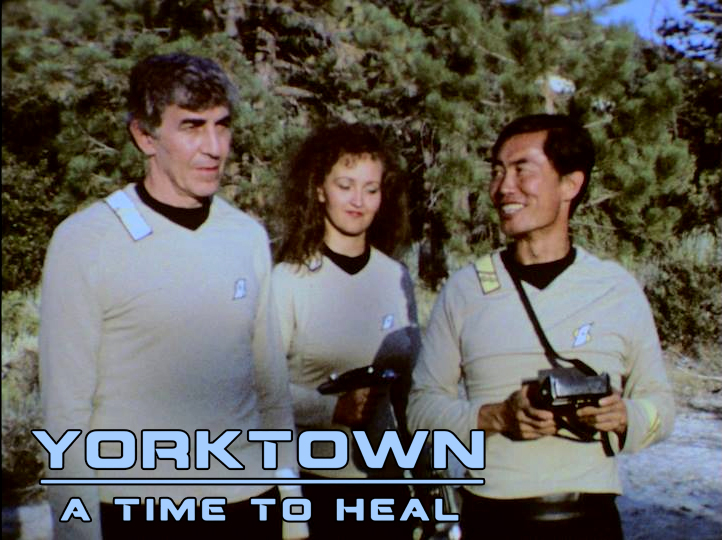
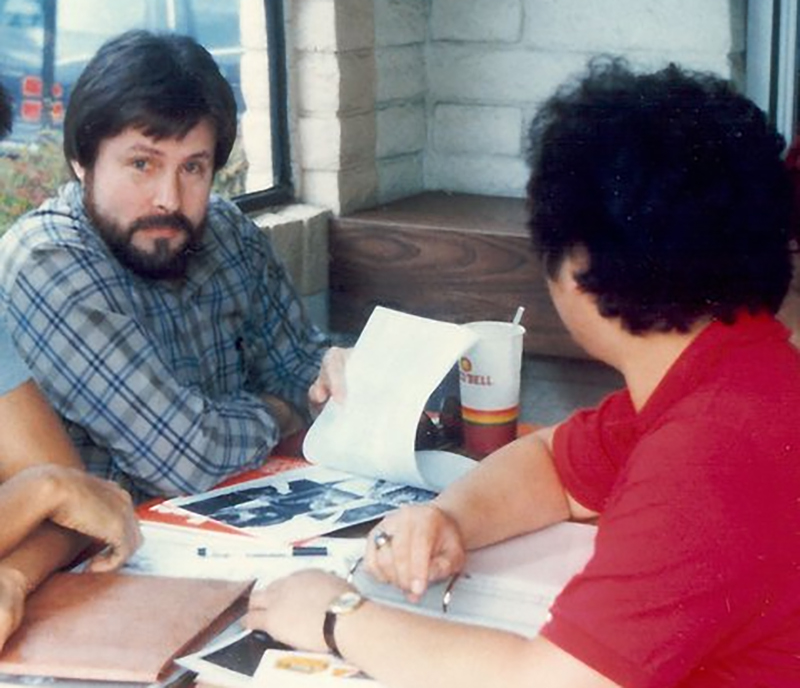
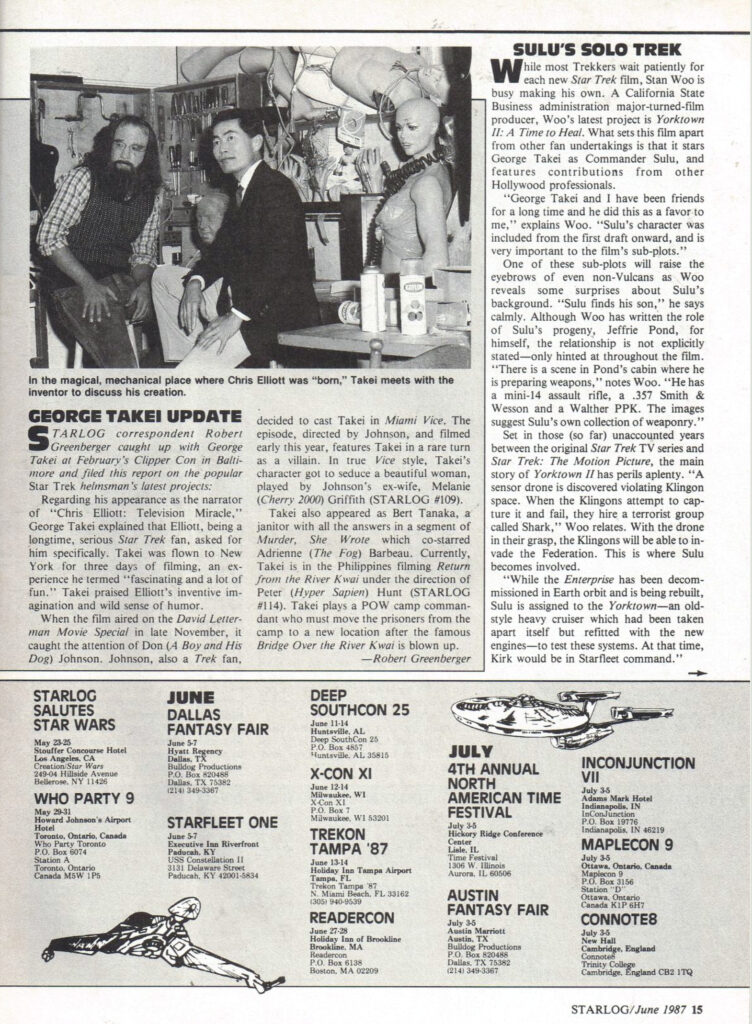

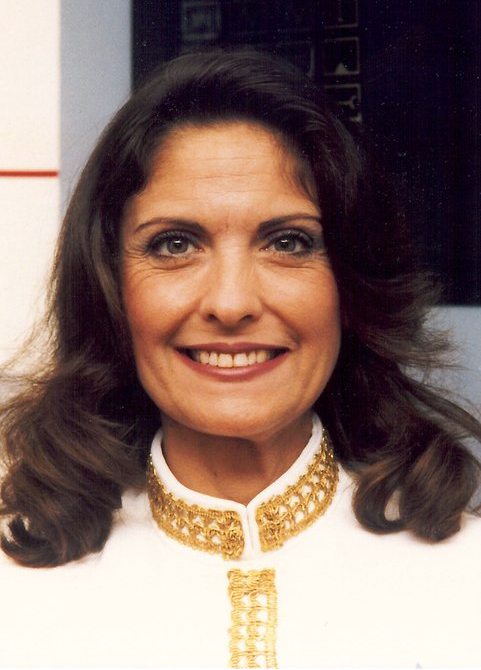
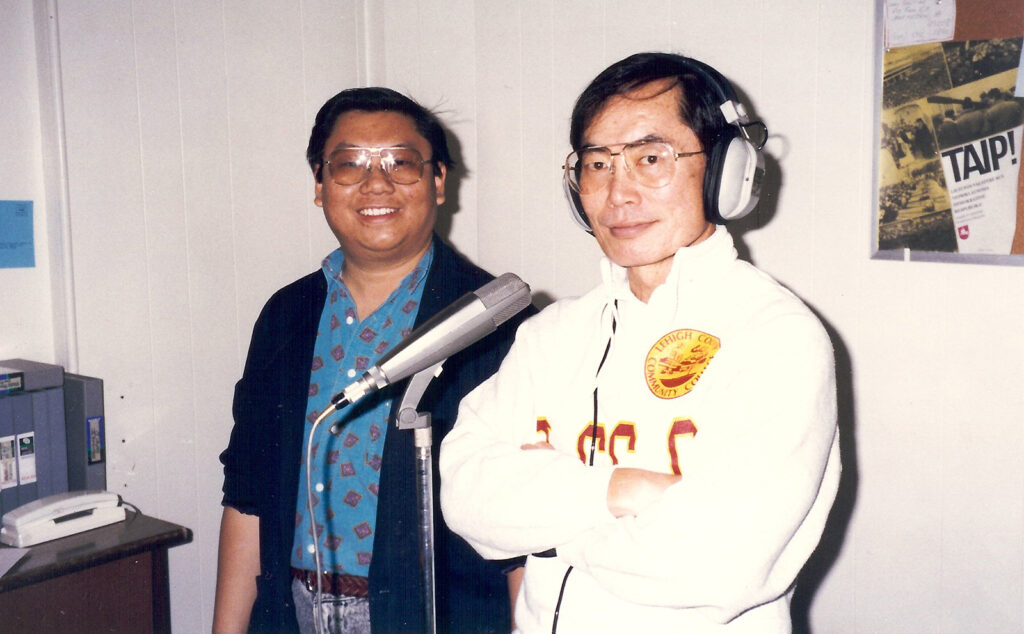
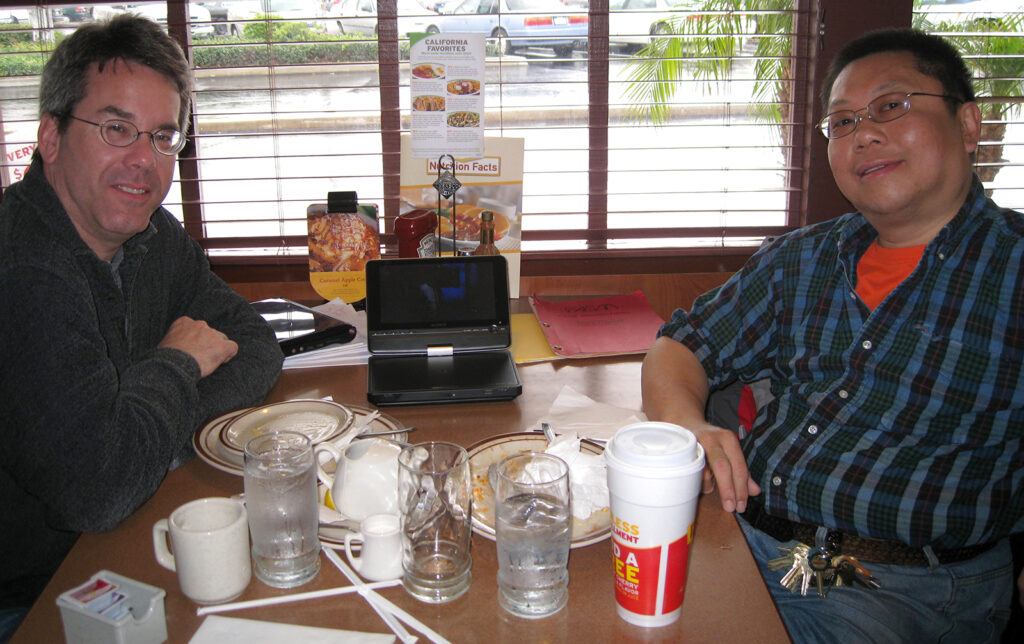
“So we had to scan all of the Super 8 Reversal Film on a Rank Cintel Flying Scanner to ¾-inch Umatic SP.” (I have absolutely no idea what that means, ”
The non-video geek translation is that they copied the film onto what was then the state-of-the-art professional analog videotape. There were ways of editing video on the tape itself rather than cutting/splicing actual film.
Where I volunteer most often has a number of films, both 8mm and 16mm, that were transferred to videotape and then transferred again to digital files.
Notice that I provided a quick translation of my own after that sentence, Jerry. I was making a little joke in the text. 🙂